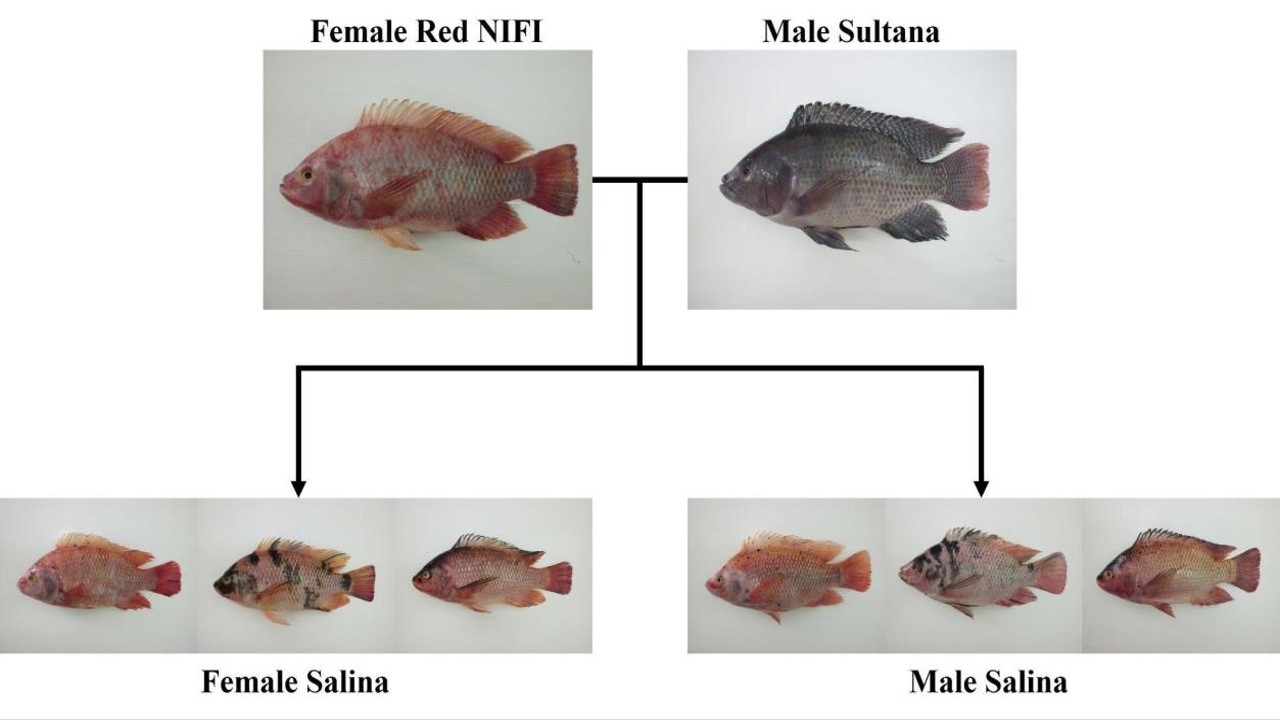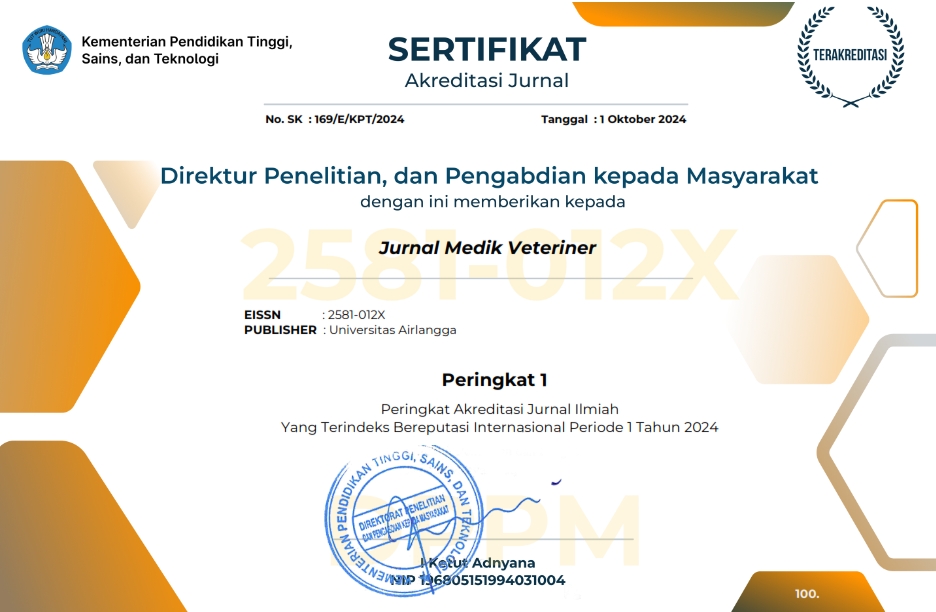Comparative Morphometric Analysis of a Salinity-Tolerant Nile Tilapia (Oreochromis niloticus) Local Strain (Salina) and Its Parental Strains

Downloads
This study focuses on the morphology of the Nile tilapia local strain (Salina), a salinity-tolerant tilapia hybrid strain developed by crossbreeding between female Nile tilapia Red NIFI with male Nile tilapia Sultana. The research aimed to analyse the morphometric characteristics of the Salina strain to understand species adaptation to suboptimal environmental conditions compared with the parental groups. A total of 60 Nile tilapia fish, ten female and ten male samples from each strain (Salina, Sultana, and red NIFI), were measured for their total length (TL), standard length (SL), head length (HL), body width (WID), dorsal fin length (DL), caudal fin length (CL), pectoral fin length (PL), caudal peduncle depth (CPD), eye diameter (ED), snout length (SNL), and body weight (BW). Each measurement parameter was then normalized by comparing it with the standard length (SL). The data were analysed using MS Excel 2019 and R v4.5.1 for all statistical analysis including MANOVA, Canonical Variance Analysis, Principal Component Analysis, and Hierarchical Clustering Analysis. Condition factor (K) and length-weight relationship (LWR) were calculated to investigate growth conditions and allometric growth patterns, respectively. Based on the findings, the six tilapia populations exhibit overlapping morphological traits, except for female Salina with slight differences in morphological variations. This implies its potential unique traits acquired from crossbreeding between two different strains. Meanwhile, male Salina showed morphometric traits closely aligned with its male parent, the Sultana strain. The condition factor across all populations indicates favourable growth conditions, although the negative allometric growth pattern suggests that length increases more rapidly than body weight, implying an adaptive trade-off in suboptimal environments.
Adeogun, A. O., Ibor, O. R., Regoli, F., & Arukwe, A. (2016). Peroxisome proliferator-activated receptors and biotransformation responses in relation to condition factor and contaminant burden in tilapia species from Ogun River, Nigeria. Comparative Biochemistry and Physiology Part - C: Toxicology and Pharmacology, 183–184, 7–19.
Albani, R. I., Budiardi, T., Hadiroseyani, Y., & Ekasari, J. (2023). Production performance of Nile tilapia Oreochromis niloticus and mineral balance in aquaponic, biofloc, and aquabioponic culture systems. Jurnal Akuakultur Indonesia, 22(1), 66–79.
Aliah, R. S. (2017). Rekayasa Produksi Ikan Nila Salin Untuk Perairan Payau di Wilayah Pesisir. Jurnal Rekayasa Lingkungan, 10(1), 17–24.
Allaman, I. B., Neto, R. V. R., de Freitas, R. T. F., Freato, T. A., Lago, A. de A., Costa, A. C., & de Lima, R. R. (2013). Weight and morphometric growth of different strains of tilapia (Oreochromis sp). Revista Brasileira de Zootecnia, 42(5), 305–311.
Ariyanto, D. (2002). Analysis Of Body Shape Variability Of Nile Tilapia Strain Gift In Three Different Levels Of Age. Gadjah Mada University Journal Fish Science, IV (1), 19–26.
Asmamaw, B., Tessema, M., Beyene, B., & Assefa, A. (2019). Length-weight relationships and condition factor of Nile tilapia, Oreochromis niloticus (Linnaeus, 1758) (Cichlidae) in Koka Reservoir, Ethiopia. International Journal of Fisheries and Aquatic Research, 4(3), 331438089.
Barylo, Ye., Loboiko, Yu., Barylo, B., Keznine, М., & Benaissa, H. (2021). Condition factor and identification of amino acid composition of three trout species in the western region of Ukraine. Egyptian Journal of Aquatic Biology and Fisheries, 25(4), 539–548.
Chicco, D., Warrens, M. J., & Jurman, G. (2021). The coefficient of determination R-squared is more informative than SMAPE, MAE, MAPE, MSE and RMSE in regression analysis evaluation. PeerJ Computer Science, 7, 1–24.
De Robertis, A., & Williams, K. (2008). Weight‐Length Relationships in Fisheries Studies: The Standard Allometric Model Should Be Applied with Caution. Transactions of the American Fisheries Society, 137(3), 707–719.
Deekrachang, C., Grudpun, C., Suvarnaraksha, A., Phomikong, P., & Jutagate, T. (2024). Length-Weight Relationship and Condition Factor of Fishes in Two Major Rivers, the Chao Phraya and the Bang Pakong, in Thailand. Tropical Life Sciences Research, 35(1), 257–273.
Dewi, K. M., Hubeis, A. V. S., & Raharja, S. (2018). Development Strategy of Salina Tilapia (Oreochromis sp.) Culture as New Varieties of Aquaculture. Manajemen IKM, 13(1), 66–74.
Diallo, F. L., Ly, M. A., Diop, L., Diatta, I., & Seck, S. M. (2022). Growth response of Nile Tilapia (Oreochromis niloticus) stocked at different densities in the LAKE-Kalassane basin in northwestern Senegal. International Journal of Biological and Chemical Sciences, 16(5), 1919–1928.
Diego, T. J. A. S., Al-Shaer, M. A. Q., & Jamali, E. A. H. Al. (2023). Re-evaluating eurahaline nature of Nile tilapia, Oreochromis niloticus: A hatchery perspective. International Journal of Fisheries and Aquatic Studies, 11(5), 223–231.
Engdaw, F. (2023). Morphometric relations and diet compositions of Nile tilapia Oreochromis niloticus (Linn. 1758) in Lake Tana Gorgora gulf, Ethiopia. Fisheries and Aquatic Sciences, 26(3), 169–180.
Faqih, I. S., Soelistyowati, D. T., & Carman, O. (2015). Phenotypes performance of tilapia best, nirwana II, jatimbulan, and sultana using floating net, and pond culture system. Jurnal Iktiologi Indonesia, 15(3), 193–200.
Gunadi, B., Setyawan, P., & Robisalmi, A. (2021). Growth, length-weight relationship, and condition factor of NIFI (Oreochromis sp.) and Srikandi Tilapia (Oreochromis aureus x niloticus) at the grow-out stage in the high salinity brackishwater ponds. Jurnal Iktiologi Indonesia, 21(2), 117–130.
Gustiano, R., Arifin, O. Z., Subagja, J., Kurniawan, K., Prihadi, T. H., Saputra, A., Ath-Thar, M. H. F., Cahyanti, W., Prakoso, V. A., Radona, D., Kusmini, I. I., & Kristanto, A. H. (2023). The Success of Freshwater Aquaculture Program: Nile Tilapia or Nila Culture in Indonesia. Zuriat, 34(2), 56.
Hasan, M., Hosen, M. H. A., Miah, M. I., Ahmed, Z. F., Chhanda, M. S., & Shahriar, S. I. M. (2020). Fecundity, length at maturity and gonadal development indices of river catfish (Clupisoma garua) of the old Brahmaputra River in Bangladesh. The Egyptian Journal of Aquatic Research, 46(3), 259–263.
Htun-Han, M. (1978). The reproductive biology of the dab Limanda limanda (L.) in the North Sea: gonosomatic index, hepatosomatic index and condition factor. Journal of Fish Biology, 13(1), 32.
Jisr, N., Younes, G., Sukhn, C., & El-Dakdouki, M. H. (2018). Length-weight relationships and relative condition factor of fish inhabiting the marine area of the Eastern Mediterranean city, Tripoli-Lebanon. Egyptian Journal of Aquatic Research, 44(4), 299–305.
Jonsson, N., & Jonsson, B. (1999). Trade‐off between egg mass and egg number in brown trout. Journal of Fish Biology, 55(4), 767–783.
Joshi, R., Meuwissen, T. H. E., Woolliams, J. A., & Gjøen, H. M. (2020). Genomic dissection of maternal, additive and non-additive genetic effects for growth and carcass traits in Nile tilapia. Genetics Selection Evolution, 52(1), 67.
Kamble, M. T., Salin, K. R., Chavan, B. R., Medhe, S. V., Thompson, K. D., & Pirarat, N. (2024). Length-weight relationship and condition factor of Nile tilapia (Oreochromis niloticus) fed diets supplemented with guava and star gooseberry leaf extract. F1000Research, 13, 540.
Koenigbauer, S. T., & Höök, T. O. (2023). Increased offspring provisioning by large female fish and consequences for reproductive efficiency. Ecology and Evolution, 13(10), 99.
Kosai, P., Sathavorasmith, P., Jiraungkoorskul, K., & Jiraungkoorskul, W. (2014). Morphometric Characters of Nile Tilapia (Oreochromis niloticus) in Thailand. Agriculture Technology and Biological Sciences Walailak, 11(10), 130.
Kurniawan, A., Siegers, W. H., Akbar, M. A., & Nur, I. S. M. (2023). The Production Model of Tilapia (Oreochromis niloticus) Cultivation with System Dynamics Approach. Journal of Aquaculture and Fish Health, 12(1), 21–30.
Kwikiriza, G., Yegon, M. J., Byamugisha, N., Beingana, A., Atukwatse, F., Barekye, A., Nattabi, J. K., & Meimberg, H. (2023). Morphometric Variations of Nile Tilapia (Oreochromis niloticus) (Linnaeus, 1758) Local Strains Collected from Different Fish Farms in South Western Highland Agro-Ecological Zone (SWHAEZ), Uganda: Screening Strains for Aquaculture. Fishes, 8(4), 64.
Laskar, B. A., Bhattacharjee, M. J., Dhar, B., Mahadani, P., Kundu, S., & Ghosh, S. K. (2013). The Species Dilemma of Northeast Indian Mahseer (Actinopterygii: Cyprinidae): DNA Barcoding in Clarifying the Riddle. PLoS ONE, 8(1), 91.
Le Cren, E. D. (1951). The Length-Weight Relationship And Seasonal Cycle In Gonad Weight And Condition In The Perch (Perca Fluviatilis). Journal of Animal Ecology, 20(2), 65.
Le Moan, A., Bekkevold, D., & Hemmer-Hansen, J. (2021). Evolution at two time frames: ancient structural variants involved in post-glacial divergence of the European plaice (Pleuronectes platessa). Heredity, 126(4), 668–683.
MMAF [Ministry of Marine Affairs and Fisheries]. (2024). Analysis of Key Performance Indicators in the Marine and Fisheries Sector for the Period 2019–2023 Vol. 2.
Munguti, J. M., Nairuti, R., Iteba, J. O., Obiero, K. O., Kyule, D., Opiyo, M. A., Abwao, J., Kirimi, J. G., Outa, N., Muthoka, M., Githukia, C. M., & Ogello, E. O. (2022). Nile tilapia (Oreochromis niloticus Linnaeus, 1758) culture in Kenya: Emerging production technologies and socio‐economic impacts on local livelihoods. Aquaculture, Fish and Fisheries, 2(4), 265–276.
Ndiwa, T. C., Nyingi, D. W., Claude, J., & Agnèse, J. F. (2016). Morphological variations of wild populations of Nile tilapia (Oreochromis niloticus) living in extreme environmental conditions in the Kenyan Rift-Valley. Environmental Biology of Fishes, 99(5), 473–485.
Nugroho, K. C., Rizky, P. N., Harijono, T., Halim, A. M., Nasuki, & Ritonga, L. B. R. (2024). Comparative Study of Growth Performance of Three Tilapia Strain in Intensive Culture System. IOP Conference Series: Earth and Environmental Science, 1328(1), 652.
Nurchayati, S., Haeruddin, Basuki, F., & Sarjito. (2021). Analysis on Land Suitability Cultivation of Saline Tilapia (Oreochromis niloticus) at The Pond in Tayu District. Indonesian Journal of Fisheries Science and Technology Available, 17, 224.
Ondang, H. M. P., Saranga, R., & Tumanduk, N. M. (2019). Constituent genetic characteristics of scad species (family Carangidae) from Bitung waters of Indonesia. Russian Journal of Agricultural and Socio-Economic Sciences, 91(7), 383–390.
Oyebola, O. O., Omitoyin, S. B., Hounhoedo, A. O. O., & Agadjihouèdé, H. (2022). Length-weight relationship and condition factor revealed possibility of mix strains in Clarias gariepinus population of Oueme Valley, Benin Republic (West Africa). Total Environment Research Themes, 3–4.
Pontzer, H., & McGrosky, A. (2022). Balancing growth, reproduction, maintenance, and activity in evolved energy economies. Current Biology, 32(12), R709–R719.
Ramli, M. Z. (2016). Characterization of Four Red Hybrids Tilapia (Oreochromis sp.) through Morphometric Characteristics. Academia Journal of Agricultural Research, 4(6), 382–386.
Rasheeq, A. A., Rajesh, M., Kumar, T. T. A., Rajesh, K. M., Kathirvelpandian, A., Kumar, S., & Singh, P. K. (2023). Stock structure analysis of the white-spotted spine foot fish (Siganus canaliculatus) along the Indian coast using Truss morphometry. Regional Studies in Marine Science, 65(1), 71.
Regala, J. A., Fernando, S. I. D., & Velasco, R. R. (2018). Morphometric Differentiation Among Four Populations of Red Tilapia (Oreochromis spp.). International Journal of Biology, Pharmacy and Allied Sciences, 7(6), 99.
Reyes, A. T. (2024). Comparison of Fulton’s Condition Factor of Nile Tilapia (Oreochromis niloticus L.) Reared in Ponds in Lubao, Pampanga, Philippines During the Dry Season. Uttar Pradesh Journal of Zoology, 45(15), 406–416.
Rusakov, D. A. (2023). A misadventure of the correlation coefficient. Trends in Neurosciences, 46(2), 94–96.
Setyawan, P., Aththar, M. H. F., Imron, I., Gunadi, B., Haryadi, J., Bastiaansen, J. W. M., Camara, M. D., & Komen, H. (2022). Genetic parameters and genotype by environment interaction in a unique Indonesian hybrid tilapia strain selected for production in brackish water pond culture. Aquaculture, 561(2), 112.
Shuai, F., & Li, J. (2022). Nile Tilapia (Oreochromis niloticus Linnaeus, 1758) Invasion Caused Trophic Structure Disruptions of Fish Communities in the South China River—Pearl River. Biology, 11(11), 94.
Silva, A. (2003). Morphometric variation among sardine (Sardina pilchardus) populations from the northeastern Atlantic and the western Mediterranean. ICES Journal of Marine Science, 60, 1352–1360.
Taukhid, T., Lusiastuti, A. M., Novita, H., Caruso, D., Avarre, J. C., Sugiani, D., Kholidin, E. B., Saputra, A., Widyastuti, Y. R., & Andriyanto, S. (2024). Resistance of Indonesian tilapia strains, Oreochromis niloticus to Tilapia Lake Virus Disease (TiLVD). Bulletin of the European Association of Fish Pathologists, 44(1), 81.
Tripathy, S. K. (2020). Significance of Traditional and Advanced Morphometry to Fishery Science. Journal of Human, Earth, and Future, 1(3), 153–166.
Quéméneur, J., Danion, M., Cabon, J., Collet, S., Zambonino-Infante, J., & Salin, K. (2022). The relationships between growth rate and mitochondrial metabolism varies over time. Scientific Reports, 12(1), 154.
Wagaw, S., Sisay, A., Bazezew, A., Enawgaw, Y., & Wosnie, A. (2024). Biological aspects of Oreochromis niloticus (Linnaeus, 1758) in Geray Reservoir (Ethiopia) for effective sustainable fisheries. Fisheries and Aquatic Sciences, 27(2), 100–110.
Wahidah, Rusli, A., Hartinah, Amrullah, & Dwinhoven, I. (2023). Evaluation of body performance of tilapia (Oreochromis niloticus). IOP Conference Series: Earth and Environmental Science, 1273(1), 89.
Washim, Md. M. R., Rubel, A. K. M. S. A., Mondal, D. K., Ahmmed, S., Sakib, Md. H., Rahman, S. L., & Islam, Md. L. (2022). Evaluation of growth performance of three strains of Nile tilapia Orechromis niloticus (L., 1758) and relation with water physico-chemical parameters reared in brackishwater ponds, Bangladesh. Journal of Aquaculture and Fish Health, 11(2), 170–181.
Wiff, R., & Roa-Ureta, R. (2008). Predicting the slope of the allometric scaling of consumption rates in fish using the physiology of growth. Marine and Freshwater Research, 59(10), 912.
Xie, M., Wang, P., Deng, Q., Liu, S., Zhang, Z., Wu, H., Xiang, J., Zhou, J., Yang, X., Song, R., Li, S., & Xie, Z. (2024). Allometric Growth Pattern and Hunger Tolerance of Hemibarbus maculatus Bleeker Larvae. Biology, 13(3), 164.
Yu, C. C., Quinn, J. T., Dufournaud, C. M., Harrington, J. J., Rogers, P. P., & Lohani, B. N. (1998). Effective dimensionality of environmental indicators: a principal component analysis with bootstrap confidence intervals. Journal of Environmental Management, 53(2), 135.
Zhang, T., Yang, Y., Liu, Y., Liu, C., Zhao, R., Li, D., & Shi, C. (2024). Fully automatic system for fish biomass estimation based on deep neural network. Ecological Informatics, 79, 102399.
Copyright (c) 2025 Yohanes Pamungkas Bawono, Kiki Mariya Dewi, Ekky Ilham Romadhona, Handang Widantara, Wisnu Sujatmiko, Ratu Siti Aliah, Sutanti Sutanti, Annisa Fitri Larassagita, Muhamad Kholik Firmansyah, Novi Megawati, Aslia Aslia, Arif Rahmat Ardiansyah, Iding Chaidir, Dedy Yaniharto

This work is licensed under a Creative Commons Attribution-NonCommercial-ShareAlike 4.0 International License.
Authors who publish in this journal agree to the following terms:
1. The journal allows the author to hold the copyright of the article without restrictions;
2. The journal allows the author(s) to retain publishing rights without restrictions;
3. The legal formal aspect of journal publication accessibility refers to Creative Commons Attribution-NonCommercial-ShareAlike 4.0 International License (CC BY-NC-SA).






11.jpg)




















